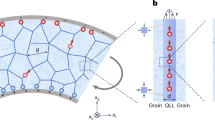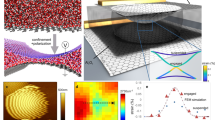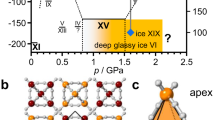Abstract
Frozen water at ambient pressure—common ice, also known as hexagonal Ih ice—is a non-polar material, even though individual water molecules are polar. Consequently, ice is not piezoelectric and cannot generate electricity under pressure. However, it may in principle generate electricity under bending, because the coupling between polarization and strain gradient (flexoelectricity) is always allowed by symmetry. Here we measure the flexoelectricity of ice and find it to be comparable to that of benchmark electroceramics such as TiO2 and SrTiO3. Moreover, the sensitivity of flexoelectric measurements to surface boundary conditions has revealed a ferroelectric phase transition around 160 K confined within the near-surface region of the ice slabs. Beyond potential applications in low-cost transducers made in situ in cold locations, these findings have profound consequences for our understanding of natural phenomena involving ice: our calculations of the flexoelectric charge density generated in ice–graupel collisions inside thunderstorm clouds compare favourably to the experimental charge transferred in such events, suggesting a possible participation of ice flexoelectricity in the generation of lightning.
This is a preview of subscription content, access via your institution
Access options
Access Nature and 54 other Nature Portfolio journals
Get Nature+, our best-value online-access subscription
$32.99 / 30 days
cancel any time
Subscribe to this journal
Receive 12 print issues and online access
$259.00 per year
only $21.58 per issue
Buy this article
- Purchase on SpringerLink
- Instant access to full article PDF
Prices may be subject to local taxes which are calculated during checkout





Similar content being viewed by others
Data availability
The data that support this study are available via figshare at https://doi.org/10.6084/m9.figshare.29378186 (ref. 76). Source data are provided with this paper.
References
Bartels-Rausch, T. et al. Ice structures, patterns, and processes: a view across the icefields. Rev. Mod. Phys. 84, 885–944 (2012).
Fumagalli, L. et al. Anomalously low dielectric constant of confined water. Science 360, 1339–1342 (2018).
Ball, P. Water as an active constituent in cell biology. Chem. Rev. 108, 74–108 (2008).
Wang, Y.-H. et al. In situ Raman spectroscopy reveals the structure and dissociation of interfacial water. Nature 600, 81–85 (2021).
Petrenko, V. F. & Whitworth, R. W. Physics of Ice (OUP Oxford, 1999).
Salzmann, C. G. Advances in the experimental exploration of water’s phase diagram. J. Chem. Phys. 150, 060901 (2019).
Rosu-Finsen, A. et al. Medium-density amorphous ice. Science 379, 474–478 (2023).
Xu, P. et al. Elastic ice microfibers. Science 373, 187–192 (2021).
Saunders, C. in Planetary Atmospheric Electricity (eds LeBlanc, F. et al.) 335–353 (Springer, 2008); https://doi.org/10.1007/978-0-387-87664-1_22
Dash, J. G., Rempel, A. W. & Wettlaufer, J. S. The physics of premelted ice and its geophysical consequences. Rev. Mod. Phys. 78, 695–741 (2006).
Thiel, D. V. Electromagnetic emission (EME) from ice crack formation: preliminary observations. Cold Reg. Sci. Technol. 21, 49–60 (1992).
Fifolt, D. A., Petrenko, V. F. & Schulson, E. M. Preliminary study of electromagnetic emissions from cracks in ice. Philos. Mag. B 67, 289–299 (1993).
Zubko, P., Catalan, G. & Tagantsev, A. K. Flexoelectric effect in solids. Annu Rev. Mater. Sci. 43, 387–421 (2013).
Lu, H. et al. Mechanical writing of ferroelectric polarization. Science 336, 59–61 (2012).
Deng, Q., Liu, L. P. & Sharma, P. Flexoelectricity in soft materials and biological membranes. J. Mech. Phys. Solids 62, 209–227 (2014).
Narvaez, J., Vasquez-Sancho, F. & Catalan, G. Enhanced flexoelectric-like response in oxide semiconductors. Nature 538, 219–221 (2016).
Yang, M. M., Kim, D. J. & Alexe, M. Flexo-photovoltaic effect. Science 360, 904–907 (2018).
Vasquez-Sancho, F., Abdollahi, A., Damjanovic, D. & Catalan, G. Flexoelectricity in bones. Adv. Mater. 30, 1705316 (2018).
Shu, L. et al. Photoflexoelectric effect in halide perovskites. Nat. Mater. 19, 605–609 (2020).
Torbati, M., Mozaffari, K., Liu, L. & Sharma, P. Coupling of mechanical deformation and electromagnetic fields in biological cells. Rev. Mod. Phys. 94, 025003 (2022).
Peng, W. et al. Flexoelectric polarizing and control of a ferromagnetic metal. Nat. Phys. 20, 450–455 (2024).
Slater, B. & Michaelides, A. Surface premelting of water ice. Nat. Rev. Chem. 3, 172–188 (2019).
Ribeiro, I. D. A. & Koning, M. D. Grain-boundary sliding in ice Ih: tribology and rheology at the nanoscale. J. Phys. Chem. C 125, 627–634 (2021).
Ma, Q., Wen, X., Lv, L., Deng, Q. & Shen, S. On the flexoelectric-like effect of Nb-doped SrTiO3 single crystals. Appl. Phys. Lett. 123, 082902 (2023).
Zubko, P., Catalan, G., Buckley, A., Welche, P. R. & Scott, J. F. Strain-gradient-induced polarization in SrTiO3 single crystals. Phys. Rev. Lett. 99, 167601 (2007).
Vales-Castro, P. et al. Flexoelectricity in antiferroelectrics. Appl. Phys. Lett. https://doi.org/10.1063/1.5044724 (2018).
Ma, W. & Cross, L. E. Flexoelectricity of barium titanate. Appl Phys. Lett. 88, 232902 (2006).
Narvaez, J. & Catalan, G. Origin of the enhanced flexoelectricity of relaxor ferroelectrics. Appl. Phys. Lett. https://doi.org/10.1063/1.4871686 (2014).
Mishima, O., Calvert, L. & Whalley, E. ‘Melting ice’I at 77 K and 10 kbar: a new method of making amorphous solids. Nature 310, 393–395 (1984).
Garg, A. K. High-pressure Raman spectroscopic study of the ice Ih → ice IX phase transition. Phys. Status Solidi a 110, 467–480 (1988).
Su, X. C., Lianos, L., Shen, Y. R. & Somorjai, G. A. Surface-induced ferroelectric ice on Pt(111). Phys. Rev. Lett. 80, 1533–1536 (1998).
Sugimoto, T., Aiga, N., Otsuki, Y., Watanabe, K. & Matsumoto, Y. Emergent high-Tc ferroelectric ordering of strongly correlated and frustrated protons in a heteroepitaxial ice film. Nat. Phys. 12, 1063–1068 (2016).
Aiga, N., Sugimoto, T., Otsuki, Y., Watanabe, K. & Matsumoto, Y. Origins of emergent high-Tc ferroelectric ordering in heteroepitaxial ice films: sum-frequency generation vibrational spectroscopy of H2O and D2O ice films on Pt(111). Phys. Rev. B https://doi.org/10.1103/PhysRevB.97.075410 (2018).
Shen, S. & Hu, S. A theory of flexoelectricity with surface effect for elastic dielectrics. J. Mech. Phys. Solids 58, 665–677 (2010).
Tagantsev, A. K. & Yurkov, A. S. Flexoelectric effect in finite samples. J. Appl. Phys. 112, 044103 (2012).
Stengel, M. Surface control of flexoelectricity. Phys. Rev. B 90, 201112 (2014).
Narvaez, J., Saremi, S., Hong, J., Stengel, M. & Catalan, G. Large flexoelectric anisotropy in paraelectric barium titanate. Phys. Rev. Lett. 115, 037601 (2015).
Martí, X. et al. Skin layer of BiFeO3 single crystals. Phys. Rev. Lett. 106, 236101 (2011).
Zhang, X. et al. Large flexoelectriclike response from the spontaneously polarized surfaces in ferroelectric ceramics. Phys. Rev. Lett. 121, 057602 (2018).
Pan, D. et al. Surface energy and surface proton order of ice Ih. Phys. Rev. Lett. 101, 155703 (2008).
Michaelson, H. B. The work function of the elements and its periodicity. J. Appl. Phys. 48, 4729–4733 (1977).
Buser, O. & Aufdermaur, A. in Electrical Processes in Atmospheres (eds Dolezalek, H., Reiter, R. & Landsberg, H. E.) 294–301 (Springer, 1976).
Mazzega, E., del Pennino, U., Loria, A. & Mantovani, S. Volta effect and liquidlike layer at the ice surface. J. Chem. Phys. 64, 1028–1031 (1976).
Batra, I. P. & Kleinman, L. Chemisorption of oxygen on aluminum surfaces. J. Electron Spectrosc. Relat. Phenom. 33, 175–241 (1984).
Scott, J. F. Ferroelectrics go bananas. J. Phys. Condens. Matter https://doi.org/10.1088/0953-8984/20/02/021001 (2008).
Pedroza, L. S., Poissier, A. & Fernandez-Serra, M. V. Local order of liquid water at metallic electrode surfaces. J. Chem. Phys. 142, 034706 (2015).
Sugimoto, T. & Matsumoto, Y. Orientational ordering in heteroepitaxial water ice on metal surfaces. Phys. Chem. Chem. Phys. 22, 16453–16466 (2020).
Poissier, A., Ganeshan, S. & Fernandez-Serra, M. The role of hydrogen bonding in water–metal interactions. Phys. Chem. Chem. Phys. 13, 3375–3384 (2011).
Mizzi, C. A., Lin, A. Y. W. & Marks, L. D. Does flexoelectricity drive triboelectricity? Phys. Rev. Lett. 123, 116103 (2019).
Mizzi, C. A. & Marks, L. D. When flexoelectricity drives triboelectricity. Nano Lett. 22, 3939–3945 (2022).
Qiao, H. et al. Mixed triboelectric and flexoelectric charge transfer at the nanoscale. Adv. Sci. 8, 2101793 (2021).
Kumar, M., Lim, J., Park, J.-Y. & Seo, H. Flexoelectric effect driven colossal triboelectricity with multilayer graphene. Curr. Appl. Phys. 32, 59–65 (2021).
Lin, S., Zheng, M., Xu, L., Zhu, L. & Wang, Z. L. Electron transfer driven by tip-induced flexoelectricity in contact electrification. J. Phys. D 55, 315502 (2022).
Olson, K. P. & Marks, L. D. What puts the ‘tribo’ in triboelectricity? Nano Lett. 24, 12299–12306 (2024).
Sobarzo, J. C. et al. Spontaneous ordering of identical materials into a triboelectric series. Nature 638, 664–669 (2025).
Milbrandt, J. A. & Morrison, H. Prediction of graupel density in a bulk microphysics scheme. J. Atmos. Sci. 70, 410–429 (2013).
Wettlaufer, J. S. & Dash, J. G. Melting below zero. Sci. Am. 282, 50–53 (2000).
Takahashi, T. Riming electrification as a charge generation mechanism in thunderstorms. J. Atmos. Sci. 35, 1536–1548 (1978).
Gaskell, W. & Illingworth, A. Charge transfer accompanying individual collisions between ice particles and its role in thunderstorm electrification. Q. J. R. Meteorol. Soc. 106, 841–854 (1980).
Williams, E. R. The tripole structure of thunderstorms. J. Geophys. Res. Atmos. 94, 13151–13167 (1989).
Jayaratne, E., Saunders, C. & Hallett, J. Laboratory studies of the charging of soft-hail during ice crystal interactions. Q. J. R. Meteorol. Soc. 109, 609–630 (1983).
Keith, W. & Saunders, C. The effect of centrifugal acceleration on the charging of a riming hailstone. Meteorol. Atmos. Phys. 41, 55–61 (1989).
Caranti, G., Avila, E. & Ré, M. Charge transfer during individual collisions in ice growing from vapor deposition. J. Geophys. Res. Atmos. 96, 15365–15375 (1991).
Avila, E. E. & Caranti, G. M. A laboratory study of static charging by fracture in ice growing by riming. J. Geophys. Res. Atmos. 99, 10611–10620 (1994).
Pereyra, R. G. & Avila, E. E. Charge transfer measurements during single ice crystal collisions with a target growing by riming. J. Geophys. Res. Atmos. 107, AAC 23-21-AAC 23-29 (2002).
Luque, M. Y., Nollas, F., Pereyra, R. G., Bürgesser, R. E. & Ávila, E. E. Charge separation in collisions between ice crystals and a spherical simulated graupel of centimeter size. J. Geophys. Res. Atmos. 125, e2019JD030941 (2020).
Gaskell, W. Field and Laboratory Studies of Precipitation Charges (Univ. Manchester, 1979).
Pamuk, B., Allen, P. B. & Fernández-Serra, M. V. Electronic and nuclear quantum effects on the ice XI/ice Ih phase transition. Phys. Rev. B 92, 134105 (2015).
Dash, J. & Wettlaufer, J. The surface physics of ice in thunderstorms. Can. J. Phys. 81, 201–207 (2003).
Ordejón, P., Artacho, E. & Soler, J. M. Self-consistent order-N density-functional calculations for very large systems. Phys. Rev. B 53, R10441 (1996).
Soler, J. M. et al. The SIESTA method for ab initio order-N materials simulation. J. Phys. Condens. Matter 14, 2745 (2002).
Perdew, J. P., Burke, K. & Ernzerhof, M. Generalized gradient approximation made simple. Phys. Rev. Lett. 77, 3865 (1996).
Dion, M., Rydberg, H., Schröder, E., Langreth, D. C. & Lundqvist, B. I. Van der Waals density functional for general geometries. Phys. Rev. Lett. 92, 246401 (2004).
Wang, J., Román-Pérez, G., Soler, J. M., Artacho, E. & Fernández-Serra, M.-V. Density, structure, and dynamics of water: the effect of van der Waals interactions. J. Chem. Phys. 134, 024516 (2011).
Pamuk, B. et al. Anomalous nuclear quantum effects in ice. Phys. Rev. Lett. 108, 193003 (2012).
Wen, X. et al. Flexoelectricity and surface ferroelectricity of water ice. figshare https://doi.org/10.6084/m9.figshare.29378186 (2025).
Acknowledgements
We thank J. Liu for her code for processing the experimental data, N. Domingo, D. Pesquera and M. Stengel for useful discussions and P. Vales, J. M. Caicedo, D. Pesquera, S. Ganguly and J. Padilla for technical support. We thank the anonymous referee #5 for suggesting and actually deriving the closed-form expression for contact charge \(Q\), as well as other constructive comments. G.C. acknowledges the support from the National Research Agency (Agencia Estatal de Investigación, No. PID2023-148673NB-I00) and from the Catalan AGAUR agency (grant no. 2021-SGR-0129). S.S. acknowledges support from the National Natural Science Foundation of China (No. 12090030). ICN2 is funded by the CERCA programme/Generalitat de Catalunya and by the Severo Ochoa Centres of Excellence programme (grant no. CEX2021-001214-S). X.W. acknowledges the support from the China Scholarship Council (grant no. 201906280215), and from the Juan de la Cierva fellowship (grant no. JDC2022-048192-I) funded by MICIU/AEI/10.13039/501100011033 and by European Union NextGenerationEU/PRTR. M.F.-S. and A.M. were funded by the US Department of Energy, Office of Science, Basic Energy Sciences, under award no. DE-SC0019394, as part of the CCS Program.
Author information
Authors and Affiliations
Contributions
G.C. conceived the idea and coordinated this work. G.C. and X.W. designed the experiments. X.W. and Q.M. performed the experiments under the supervision of G.C. and S.S. A.M. and M.F.-S. performed the ab initio calculations and associated data modelling. X.W. performed the calculations and analysis of the electrification section. X.W. and G.C. wrote the manuscript with input from all the other authors. All authors discussed the results and commented on the manuscript.
Corresponding authors
Ethics declarations
Competing interests
The authors declare no competing interests.
Peer review
Peer review information
Nature Physics thanks Ji Chen, Daesu Lee and the other, anonymous, reviewer(s) for their contribution to the peer review of this work.
Additional information
Publisher’s note Springer Nature remains neutral with regard to jurisdictional claims in published maps and institutional affiliations.
Supplementary information
Supplementary Information
Supplementary Discussions 1–12, Figs. 1–14 and Table 1.
Source data
Source Data Fig. 1
Statistical source data.
Source Data Fig. 2
Statistical source data.
Source Data Fig. 3
Statistical source data.
Source Data Fig. 4
Statistical source data.
Source Data Fig. 5
Statistical source data.
Rights and permissions
Springer Nature or its licensor (e.g. a society or other partner) holds exclusive rights to this article under a publishing agreement with the author(s) or other rightsholder(s); author self-archiving of the accepted manuscript version of this article is solely governed by the terms of such publishing agreement and applicable law.
About this article
Cite this article
Wen, X., Ma, Q., Mannino, A. et al. Flexoelectricity and surface ferroelectricity of water ice. Nat. Phys. (2025). https://doi.org/10.1038/s41567-025-02995-6
Received:
Accepted:
Published:
DOI: https://doi.org/10.1038/s41567-025-02995-6
This article is cited by
-
Streaming flexoelectricity in saline ice
Nature Materials (2025)
-
From bending to lightning
Nature Physics (2025)



